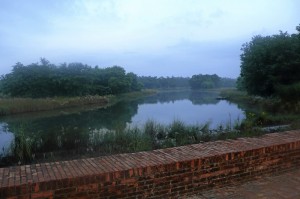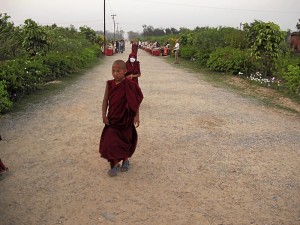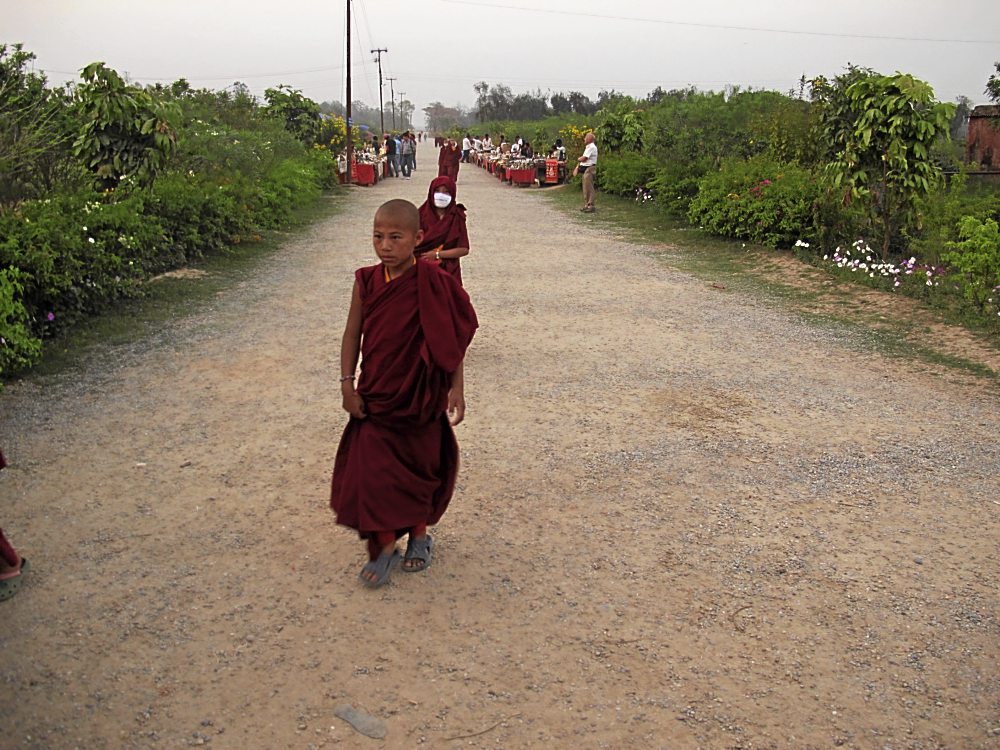
Lumbini is really nothing more than a small village at a crossroads on the hot and dusty lowland plains of the flat, agricultural Terai region of southern Nepal.
In this isolated place, the Buddha was born, making Lumbini one of the four most important pilgrimage sites for Buddhists.
The three other pilgrimage sites, located in neighboring India, mark the places where the Buddha attained enlightenment, preached his first sermon, and where he died and was cremated.
In India, imposing temples built centuries ago are landmarks to events in the Buddha’s life, ceremoniously inspiring and capturing pilgrim devotion.
Right outside temple precincts, the mundane overpowers the spiritual: There is the expected maze of hawkers, souvenir shops, refreshment stands and restaurants that lead to roads lined with hotels catering to all categories of pilgrims.
Rural Lumbini is the opposite. In a quiet, agricultural setting, not as “developed” as the three other Buddhist sites, Lumbini is where the mundane does not overpower the spiritual. There are few souvenir hawkers. Restaurants are hard to find, and not many hotels. Most pilgrims stay in monasteries.
The aura of peace in rural Lumbini is exceptional.
The United Nations commissioned Japanese master architect Kenzo Tange to do a master plan for Lumbini in 1978, and the strength of the Tange plan is this: Its architecture provides a spiritual experience for the pilgrim.

Tange’s spiritual experience does not confront pilgrims with stone temples or any religious symbolism that is larger than life. Tange’s buildings house everyday functions: research center, museum, visitor center and management offices.
No buildings line the long, open walkway leading to the Sacred Garden where Buddha was born. It is simply a long and straight, quiet, tree-lined outdoor walkway with a canal at its center.
Central to spiritual experience
The walkway is central to the spiritual experience elicited by the Tange plan, a subliminal and unexpected experience open to all but, as experiences go, unnoticed by many.

Kenzo Tange carved out a 1 x 3-mile rectangular area out of flat Lumbini agricultural land, relocated its residents, and turned the area into a large, reforested garden, evoking the birth of the Buddha in the lush Lumbini forest thousands of years ago.
Divided into three equal 1 x 1-mile squares, each sector of the master-planned area is designated for a special function.
The northernmost sector is New Lumbini Center, where all day-to-day pilgrim and management functions are located: information offices, shops, food outlets, first aid and offices for Lumbini Development Trust, which manages the site.
The central sector is the Monastic Zone where different monasteries built by Buddhist house monks and pilgrims are located.
At the southern sector is the Sacred Garden where archaeological relics mark the actual location of the Buddha’s birthplace.
The journey, done on foot, which begins at New Lumbini Center through the Monastic Zone leading to the Sacred Garden, is a journey that happens on two levels.
It can be a purely physical experience, a long two-mile walk that gets the pilgrim from one point to another, or from the entrance to the Sacred Garden.
However, the subliminal effect of this journey is what gives spiritual value to Lumbini. It is the understated, fine quality that is the core of the Lumbini experience, setting this shrine apart from all other Buddhist shrines.
Public perception of architects is that they build structures, but that is only part of what they do. The success of any architect lies in the reaction elicited from people as they experience the modulation of space and light while moving through his work.
In a subtle, sophisticated manner, the Tange master plan puts into motion a sequence of spaces that are revealed subtly, as pilgrims experience on foot a procession of events designed to awaken spirituality.

The entire experience takes place on a mile-long, brick-paved outdoor walkway running in a straight line from New Lumbini Center to the Sacred Garden.
Forgetting the mundane
Walking between a navigable canal and row of trees planted equidistantly from each other, the mundane drops away the farther the pilgrim walks from New Lumbini Center. The sky and trees reflect on the canal, sounds of leaves in the wind, birds and the occasional jackal howl pierce the quiet.
By the time the pilgrim has walked past the monasteries and arrives at the eternal flame marking the entrance to the Sacred Garden, he has forgotten the mundane, and is at peace and ready for the Buddha.
At this point, the walkway ramps down, compresses between high brick walls as if to squeeze the last of the mundane from the pilgrim’s consciousness, and becomes a causeway crossing an artificial lake where at last the Sacred Garden at the center of the lake comes into view.
The Sacred Garden is open to the sky, visually bound by the Himalayan foothills in the distance, serene, totally connected to the Buddhist universe, and a place of peace and unity.
Tange sequences spaces along the walk, to achieve the experience of peace upon arriving at the Sacred Garden. This subliminal experience is the essence of Buddhism.
This subliminal experience is misunderstood by many who feel that the Kenzo Tange master plan is irrelevant to Lumbini today, without realizing that this is an outstanding work of 20th-century architectural heritage.
Feedback and comments are welcome at [email protected].














































